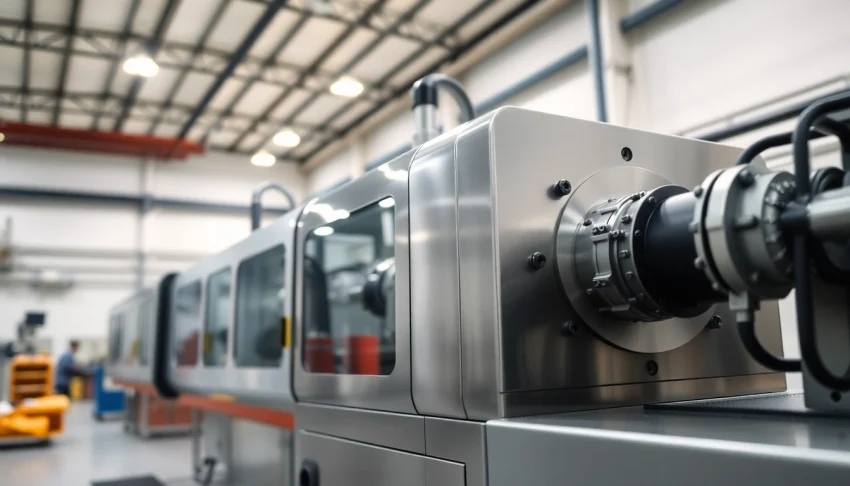Introduction to Blow Molding Machines
Blow molding machines have revolutionized the manufacturing landscape, particularly in the production of hollow plastic products such as bottles, containers, and various custom shapes. These machines leverage advanced engineering and technology to produce items that are not only efficient in design but also cost-effective in production. As industries move towards mass production and innovative product designs, understanding the workings of blow molding machines becomes essential. This article delves into the intricacies of blow molding technology, exploring its processes, applications, features, benefits, challenges, and future trends. For more comprehensive insights on advanced machinery solutions, check out this Blow Molding Machine
What is a Blow Molding Machine?
A blow molding machine is a specialized industrial device designed to manufacture hollow plastic parts. The process primarily involves melting plastic and forming it into a parison, which is then inflated within a mold to create the desired shape. With the increasing demand for plastic products, the functionality of blow molding machines has evolved, offering features that enable flexibility, efficiency, and sustainability.
Types of Blow Molding Processes
There are three primary types of blow molding processes, each with different applications and manufacturing outcomes:
- Extrusion Blow Molding (EBM): This is the most common type where plastic is melted and extruded into a tube-like parison, which is then clamped into a mold and inflated.
- Injection Blow Molding (IBM): In this process, molten plastic is injected into a mold to form a preform, which is then transferred to a blow mold where it is inflated.
- Injection Stretch Blow Molding (ISBM): This method combines aspects of injection and blow molding to create high-quality, lightweight plastic bottles, enhancing wall strength and clarity.
Applications in Various Industries
Blow molding machines are used across multiple sectors, reflecting their versatility:
- Food and Beverage: Production of bottles for beverages, jars for food items, and various containers designed to maintain freshness.
- Consumer Goods: Manufacturing items such as shampoo bottles, detergent containers, and toys.
- Automotive: Creation of fuel tanks, air duct housings, and other plastic components.
- Healthcare: Production of medical containers, laboratory equipment, and drug delivery systems.
Key Features of Modern Blow Molding Machines
Energy Efficiency and Performance
Modern blow molding machines are designed to minimize energy consumption while maximizing output. Many machines now utilize advanced drive systems, such as servo motors, to enhance energy efficiency by reducing waste and improving precision. This results in lower operational costs and a reduced environmental footprint.
Automation and Control Systems
The integration of automation in blow molding technology has significantly improved manufacturing processes. Smart control systems allow for real-time monitoring and adjustments, ensuring consistent product quality and reducing downtime. Automated systems can also manage changes in the production process without human intervention, allowing for quick adaptations to varying production needs.
Customizability for Different Products
Blow molding machines offer extensive customization options, enabling manufacturers to design specific molds that cater to unique product requirements. This flexibility allows businesses to innovate and differentiate their products in a competitive market, from intricate bottle shapes to specialized containers.
Benefits of Using Blow Molding Machines
Cost-Effectiveness in Production
One of the most significant advantages of blow molding machines is their cost-effectiveness. The process is suitable for large-scale production, which reduces the cost per unit. This is particularly beneficial in industries where high volumes of products are required, as molds can be constructed to accommodate numerous cavities, thus speeding up production and lowering costs.
Speed and Efficiency Improvements
Blow molding technology allows for rapid production cycles, significantly reducing time-to-market for new products. Machines are capable of producing thousands of items in a single shift, leading to higher throughput and better fulfillment of customer demands.
Quality Control Measures
Quality control is vital in manufacturing, and modern blow molding machines incorporate several features to ensure products meet high standards. Automated inspections, real-time monitoring, and data analytics help identify potential defects, leading to improved consistency and reduced waste.
Common Challenges with Blow Molding Machines
Maintaining Equipment
Regular maintenance is crucial to ensure blow molding machines run efficiently. Manufacturers must implement preventative maintenance schedules to address wear and tear, which can lead to expensive downtimes if not managed properly. Additionally, training personnel on the proper operation of machinery can extend its lifespan.
Quality Assurance and Defects
While quality control measures exist, defects can still occur due to issues such as inconsistent material quality or improper machine settings. Continuous training and investment in technology to monitor product quality are essential to minimize defects.
Investment and Operating Costs
The initial investment in blow molding technology can be substantial. However, with the right machine, the operational efficiencies can lead to reduced costs over time. Businesses need to consider the long-term benefits against the initial expenditure to make informed decisions about their manufacturing capabilities.
Future Trends in Blow Molding Technology
Smart Manufacturing and IoT Integration
The future of blow molding is paving the way for smart manufacturing through IoT integration. Machines connected to the Internet can share real-time data, enhance predictive maintenance techniques, and even facilitate remote troubleshooting. This enhances operational efficiency and allows for better decision-making based on data analytics.
Sustainable Practices in Blow Molding
Sustainability continues to be a significant focus in manufacturing. The blow molding industry is responding by incorporating recycled materials into production and developing machines that consume less energy. Additionally, manufacturers are being encouraged to design products for recyclability and reduce waste throughout the production process.
Advancements in Materials and Design
Advancements in material science are leading to the development of new, lightweight, and durable plastic materials specifically for blow molding applications. These innovations allow manufacturers to create products that are not only cost-effective but also environmentally friendly by replacing traditional plastics with bio-based alternatives.
